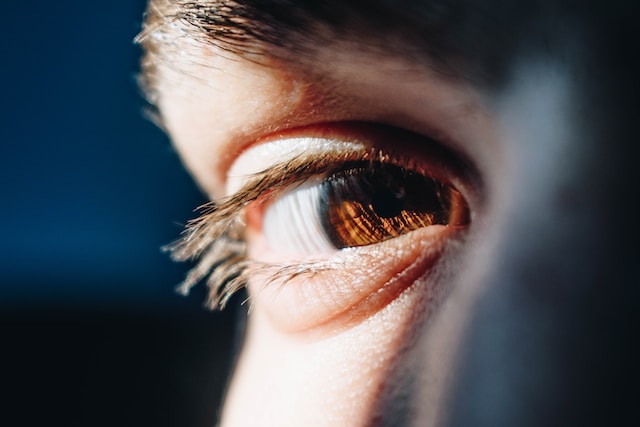Introduction
A person with hyperopia (farsightedness) sees distant objects clearly but close objects appear blurry. This is because the eyeball is too short and the cornea is too flat to bend light correctly onto the retina for up-close vision.
Hyperopia is usually diagnosed as part of a routine eye health exam. Glasses and contact lenses are prescribed to correct the problem by refocusing light rays on the retina to clear up-close vision.
What is Hyperopia
Hyperopia is the opposite of myopia – a condition in which close objects appear blurry. It happens when the eyeball is too short or the cornea (the clear front surface that passes light to the retina) is too flat, and it’s usually present from birth or develops as people get older. Also known as farsightedness, it affects 5-10% of the United States population.
The most common treatment for farsightedness is glasses or contact lenses, which refocus light rays on the retina to improve vision. For lower levels of hyperopia, laser surgery called LASIK or refractive lens exchange may be an option, which permanently changes the shape of your eye’s natural lens or replaces it with an artificial one.
The cause of hyperopia varies from person to person. In children, parents often note a deviation of the eyes that can be unmasked by cycloplegic examination and treated with glasses. In adults, the cause is less obvious and can be caused by other factors including aging and decreased ciliary muscle tone.
Symptoms of Hyperopia
People with farsighted vision find distant objects appear clearer than nearby ones. This happens because light rays focus at a point behind the retina instead of directly on it, as they should. Farsightedness is more common in children than myopia and can go undiagnosed if kids don’t get regular eye exams between the ages of 3 and 8. Children with severe farsightedness may develop squinting or crossed eyes.
Eyeglasses and contact lenses can correct farsightedness by refocusing light rays on the retina. Lower levels of farsightedness can also be treated with refractive surgery such as LASIK or refractive lens exchange, where your natural eye’s lens is replaced with an artificial one that adjusts the way it focuses. Farsightedness tends to worsen with age, as you develop presbyopia due to the aging of your eye’s lens. This can make it harder to read or work up close. It is also associated with symptoms such as a feeling of tiredness or strain when working up close and can lead to poor posture and squinting.
Diagnosing Hyperopia
The best way to diagnose farsightedness is to come in for a full eye exam. Your eye doctor will use a retinoscope and a visual acuity test to measure your distance and near vision. They may also conduct muscle integrity, slit lamp, and refractive tests.
Your eyes will be dilated with eye drops for this examination. This is common and painless, and it allows your doctor to examine the inside of your eye in greater detail.
The treatment for hyperopia aims to correct the way that your eye focuses light on the retina. It may involve glasses or contact lenses, or it might be a surgical procedure like LASIK or PRK. These procedures reshape your cornea or replace your lens with an implant to correct the focusing problem. Mild farsightedness is often not treated in children, because their young eyes are able to compensate well with accommodation. By age 40, however, most adults require correction to see clearly.
How to treat Hyperopia
People with hyperopia usually need corrective lenses. These help to focus light properly on the retina, allowing clear close-up vision. People with mild cases of farsightedness may not require these lenses, as their eyes can compensate by focusing on nearer objects. However, people over age 40 often begin to lose their close-up vision due to a condition called presbyopia, in which the lens of the eye becomes less flexible and less able to refocus on nearer objects.
People with hyperopia can have a variety of treatments to improve their sight, including eyeglasses or contact lenses, refractive surgery (LASIK or PRK), and implanted contact lenses or artificial intraocular lenses. Eye health professionals recommend regular vision screenings, starting at birth. This can ensure that children with hyperopia are diagnosed and treated before their visual acuity begins to decline. A comprehensive eye exam will check for both myopia (nearsightedness) and hyperopia. This will include tests that measure how light focuses in the eye, such as reading letters on an eye chart.
Frequently Asked Questions (FAQs)
Q1: Can hyperopia be prevented?
A1: Hyperopia is primarily a result of genetic and structural factors. While it cannot be prevented, regular eye examinations can help detect and address hyperopia early.
Q2: Does hyperopia worsen with age?
A2: Hyperopia can remain stable throughout a person’s life, or its effects can change with age. Presbyopia, an age-related condition, can occur alongside hyperopia and further affect near vision.
Q3: Can hyperopia cause eye strain?
A3: Yes, hyperopia can strain the eyes as they continuously adjust to compensate for the refractive error. This strain may lead to discomfort, headaches, and reduced visual acuity.
Q4: Can hyperopia be corrected with LASIK surgery?
A4: Yes, LASIK surgery can be an effective option for correcting hyperopia. However, not all individuals are suitable candidates. A comprehensive evaluation with an eye surgeon is necessary to determine eligibility.
Conclusion
Hyperopia, or farsightedness, affects individuals worldwide and can impact daily activities that require near vision. By understanding the causes, symptoms, and treatment options for hyperopia, you can make informed


